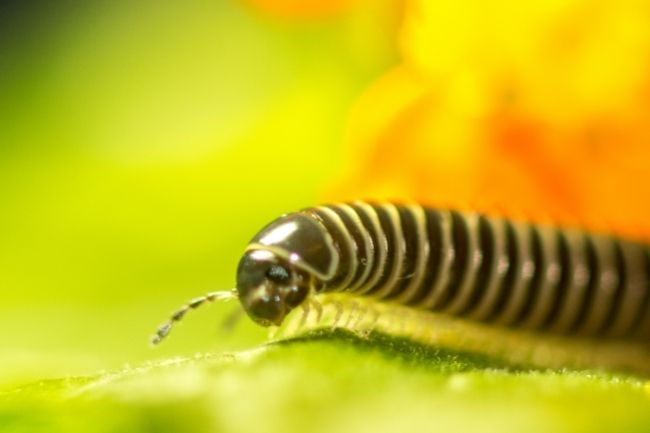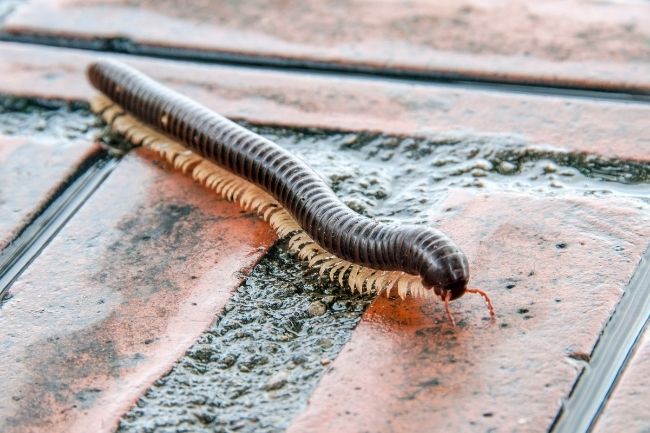Millipedes do have a set of antennae on their heads, though these aren’t always easy to see in some species. Their size can vary, but they are used as important sensory organs. Millipedes have ‘elbowed’ antennae, making it easier for them to use their antennae to feel around them.
Contents
What are antennae?

Antennae are common appendages among arthropods. They are usually located just in front of or above the eyes. These antennae come in pairs and can be many different shapes and sizes. Crabs have small antennae that are barely visible, whereas moths can have elaborate plume-like antennas.
The purpose of these appendages can vary a great deal, as depending on the species, they can serve different purposes. Species like ants can use their antenna to help them communicate with each other, and gather information about other ants they meet, by picking up pheromones and touching each other.
Some species are thought to use their antennae to guide them on long-distance journeys, helping to sense direction. Other common uses are to detect temperate and humidity. Certain butterfly species even use their antennae to seduce their partners, by putting on displays with them.
| Type | Description |
|---|---|
| Filiform Antennae | Long, slender antennae that are thread-like in appearance, often found in millipedes belonging to the class Diplopoda |
| Clubbed Antennae | Antennae with a thickened, club-like tip, commonly seen in millipedes of the order Polydesmida |
| Beaded Antennae | Antennae characterized by bead-like segments, observed in certain millipede species |
| Setose Antennae | Antennae covered with dense sensory hairs or setae, providing enhanced sensitivity to the environment |
Antennae size and shape can change as species move from being juveniles to adults, with antennae on caterpillars often being barely visible, whereas adult butterflies and moths can have substantial antennae. This is usually because the purpose of the antennae changes as the species matures.
Also read: How Butterflies Taste? With Feet, Antenna or Tongue?
Do millipedes have antennae?
Millipedes do have a set of antennae, however, they aren’t particularly prominent compared to those of many other arthropods. They have what is known as ‘elbowed’ antennae. This means there is a slight kink in them, allowing the antennae to be used to touch surfaces and objects around them much more easily.
Millipedes use their antennae to help them sense the world around them. One of the reasons they need these additional sensory organs is because their eyesight is so poor. Millipedes don’t have compound eyes, instead, they have simple eyes, known as ocelli. These eyes aren’t very good at creating images, instead primarily detecting light and dark. Some millipede species don’t have any eyes at all, particularly cave-dwelling species.

Millipedes spend most of their time in dark places, such as under rocks. This is in part because they lose moisture easily, and can dry up in the sun. Therefore, it’s useful for them to know when they are heading into the light; however, it isn’t necessary for them to be able to see more detailed images. Their antennae can help them feel the way in the darkness and understand what is before them.
As well as the antennae themselves, millipedes have what is known as Tömösváry organs, which sit just before the antennae. It’s not known exactly what purpose these have, but it’s thought they might help to detect humidity.
| Function | Description |
|---|---|
| Sensory Perception | Antennae serve as sensory organs, detecting chemical cues, vibrations, and touch in the millipede’s habitat |
| Navigation | Millipedes use their antennae to navigate their surroundings, sensing obstacles and potential food sources |
| Mate Recognition | Antennae play a role in mate recognition and communication, allowing millipedes to identify potential mates |
| Environmental cues | Antennae help millipedes detect changes in temperature, humidity, and other environmental factors |
Along with the antennae, there are a series of hairs known as sensilla. These help to increase the surface area of the antennae, making them more sensitive. These hairs cover the whole of the antennae but become denser towards the top.
Antennae are made up of a number of different sections. At the base are the scape and pedicel. After this comes a series of flagellomere, the number of which can vary between species.
Also read: Wondering “If Millipede is an Insect”? – Explained
Fumbling around in the dark
The antenna on even the largest species of millipede is certainly nothing to write home about, being very understated to say the least. Yet, they serve a vital role in the millipede’s life, helping to guide them through a dark and mysterious world.
One reason for their small size may simply be that millipedes spend most of their time squeezing through crevices or tunnelling into the soil. In these conditions, large showy antennae would simply get in the way.
However, smaller antennae are capable of doing just what the millipedes need them to do, helping them to feel around at their surroundings and understand where they are going and what might be before them.
Yet, antennae certainly can’t do everything for the little millipede, and larger predators, too far out of the millipede’s eyesight, and too far away from their constantly feeling antennae, could easily be missed. For this reason, a millipede’s best form of defence is staying hidden. If this fails, millipedes can exude a toxic substance to put off those that might consider them to be a tasty snack.

